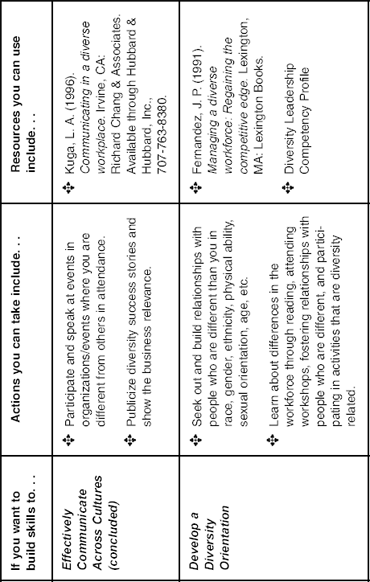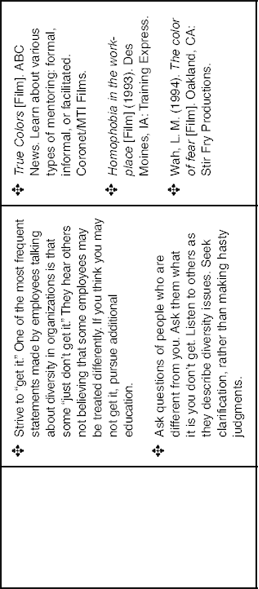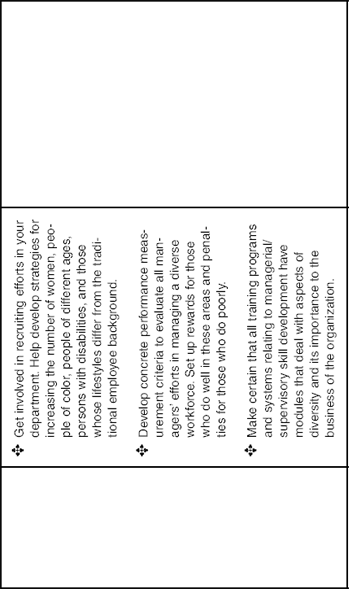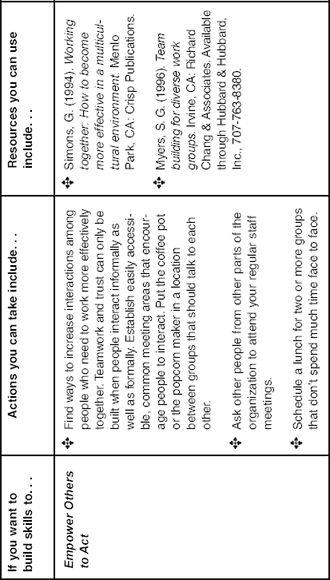The Managing Diversity Profile
Before you begin reading this pocket guide, take a minute to complete Exercise 1-1, the Managing Diversity Profile (adapted from the comprehensive 360° Diversity Leadership Competency Profile from Hubbard & Hubbard, Inc.). This self-assessment examines your current level of skill for managing diversity and provides you feedback on six key competencies for managing diversity.
Exercise 1-1. Managing Diversity Profile by Dr. Edward E. Hubbard
Directions: This profile is designed to help you examine your diversity management skills. We hope that you will be frank and honest in rating these items and that you indicate your rating based on what you believe to be true about how you respond in a diverse work environment. You should indicate your rating by placing a single checkmark on the number in the brackets next to the appropriate term that best reflects “what you actually do”—for example, ![]() Never, or
Never, or ![]() Rarely, or
Rarely, or ![]() Sometimes, or
Sometimes, or ![]() Often, or
Often, or ![]() Usually, or
Usually, or ![]() Almost Always. Only one checkmark should be indicated for each item.
Almost Always. Only one checkmark should be indicated for each item.
Section One
1. Communicates a diversity vision for organizational success that sparks excitement in others.
[1] Never [2] Rarely [3] Sometimes [4] Often
[5] Usually [6] Almost Always
2. Encourages managers to promote and explain the diversity vision.
[1] Never [2] Rarely [3] Sometimes [4] Often
[5] Usually [6] Almost Always
3. Regularly measures your own diversity progress and the progress of your staff toward the diversity vision.
[1] Never [2] Rarely [3] Sometimes [4] Often
[5] Usually [6] Almost Always
4. Asks employees for their input to the diversity vision.
[1] Never [2] Rarely [3] Sometimes [4] Often
[5] Usually [6] Almost Always
Section Two
5. Communicates easily with people of diverse backgrounds.
[1] Never [2] Rarely [3] Sometimes [4] Often
[5] Usually [6] Almost Always
6. Speaks effectively in front of diverse groups.
[1] Never [2] Rarely [3] Sometimes [4] Often
[5] Usually [6] Almost Always
7. Gives constructive feedback effectively to all groups regardless of race, gender, or other diverse characteristics.
[1] Never [2] Rarely [3] Sometimes [4] Often
[5] Usually [6] Almost Always
8. Listens to feedback from diverse groups without becoming defensive.
[1] Never [2] Rarely [3] Sometimes [4] Often
[5] Usually [6] Almost Always
Section Three
9. Discusses diversity as a strength in this organization.
[1] Never [2] Rarely [3] Sometimes [4] Often
[5] Usually [6] Almost Always
10. Gives people of diverse backgrounds equal opportunity for training, promotion, etc.
[1] Never [2] Rarely [3] Sometimes [4] Often
[5] Usually [6] Almost Always
11. Seeks to understand the cultural norms and practices of groups other than your own.
[1] Never [2] Rarely [3] Sometimes [4] Often
[5] Usually [6] Almost Always
12. Makes use of the diverse talents of people in work assignments, decision making, etc.
[1] Never [2] Rarely [3] Sometimes [4] Often
[5] Usually [6] Almost Always
13. Consults with diverse groups to find innovative ways to make change happen.
[1] Never [2] Rarely [3] Sometimes [4] Often
[5] Usually [6] Almost Always
14. Gets input from employees about changes that will have an impact on them.
[1] Never [2] Rarely [3] Sometimes [4] Often
[5] Usually [6] Almost Always
15. Works to resolve diverse work group issues related to impending changes.
[1] Never [2] Rarely [3] Sometimes [4] Often
[5] Usually [6] Almost Always
16. Keeps people informed during the process of change.
[1] Never [2] Rarely [3] Sometimes [4] Often
[5] Usually [6] Almost Always
Section Five
17. Solicits input from groups regardless of race, gender, or other characteristics.
[1] Never [2] Rarely [3] Sometimes [4] Often
[5] Usually [6] Almost Always
18. Manages more like a colleague than as a boss.
[1] Never [2] Rarely [3] Sometimes [4] Often
[5] Usually [6] Almost Always
19. Shares accountability with diverse groups equitably.
[1] Never [2] Rarely [3] Sometimes [4] Often
[5] Usually [6] Almost Always
20. Rewards diverse groups for their contributions in a fair manner.
[1] Never [2] Rarely [3] Sometimes [4] Often
[5] Usually [6] Almost Always
Section Six
21. Delegates responsibility fully to those qualified to do the work regardless of race, gender, or other characteristics.
[1] Never [2] Rarely [3] Sometimes [4] Often
[5] Usually [6] Almost Always
22. Works to customize training needs to fit diverse work group members.
[1] Never [2] Rarely [3] Sometimes [4] Often
[5] Usually [6] Almost Always
23. Counsels and mentors diverse work group members on their interests, preferences, and careers.
[1] Never [2] Rarely [3] Sometimes [4] Often
[5] Usually [6] Almost Always
24. Demonstrates valuing diversity through his/her own actions.
[1] Never [2] Rarely [3] Sometimes [4] Often
[5] Usually [6] Almost Always
Each item has a possible maximum score of 6 points.
Step One: Enter the score for each item in the Profile Scoring Grid on page 7 using the following numbers for each response (for example, if you placed a checkmark in the brackets next to the term “Usually,” then Usually = 5 points):
[1] Never [2] Rarely [3] Sometimes [4] Often
[5] Usually [6] Almost Always
Step Two: After indicating the numerical points in the left-hand side of the Profile Scoring Grid, add your scores horizontally, enter your score under “Competency,” and draw a “bar” to the appropriate box under the Total Score Graph based on the total points you tallied. See sample below (5 pts. + 6 pts. + 2 pts. + 1 pt. = 14 points):
Sample

Your Overall Profile Score is the sum totals of all competencies (Champion for Diversity, Communicates Across Cultures, Diversity Orientation, Leads Change, Empowers Others to Act, and Develops Others) divided by 6. Calculate your Overall Profile Score and draw a “bar” to the appropriate box on the right under the Total Score Graph, based on the total points.
The interpretation of your Overall Profile Score is shown below:
Excellent: (20 to 24)
Congratulations! You have successfully integrated the diversity management competencies into your style and the way you interact with others. This makes it possible for you and the organization to strategically capitalize on employee differences. You should try to expand your lessons learned as personal development and help others in your organization who may not be as far along as you.
Very Good: (17 to 19)
You are making progress and have all the ingredients for even greater success. Focus on the areas that received the lower scores and address them.
Average: (15 to 16)
You have some core strengths but there are areas for growth and improvement. Review the areas that received the lowest scores and discuss them with your manager and/or a peer coach/mentor who is effective at managing a diverse workforce. At the same time, also look at one or two areas that received the highest scores and think about ways to sustain these strengths.
Poor—Potential Problems Ahead: (14 and below)
You may already be running into problems managing your diverse workforce. Pick one or two key competency areas that received low scores on the assessment, and focus your efforts using the skills outlined in this pocket guide. Consider obtaining a peer coach/mentor who is effective at managing a diverse workforce to help you bring your skills to a highperforming level. Attend managing diversity workshops and other developmental activities for improvement.
To get you started, use the Managing Diversity Profile Action Plan Start-up Toolkit in Figure 1-1, which is packed with recommended activities, suggestions, and tools you can use to enhance your skills in each area.
Figure 1-1. Managing Diversity Profile Action Plan Start-Up Toolkit

Managing and leading in a diverse work environment, in general, requires that you follow the ten guidelines in Figure 1-2.
Figure 1-2. Ten Guidelines for Managing and Leading in a Diverse Work Environment*
|
Activity | |
|
Search out challenging opportunities to utilize diversity to change, grow, innovate, and improve. | |
|
Experiment, take risks, learn from the accompanying mistakes, and seek feedback. | |
|
Envision an inclusive, strategically anchored future using diversity. | |
|
Enlist others in a common vision by incorporating and appealing to their values, interests, hopes, and dreams. | |
|
Foster collaboration by promoting cooperative goal setting and building trust. | |
|
Strengthen people by giving power away, providing choices, developing competence, assigning critical tasks, and offering visible support. | |
|
Set the example by seeking cultural knowledge and behaving in ways that are consistent with shared values. | |
|
Achieve small wins that promote consistent progress and build commitment by sharing measurable diversity results. | |
|
Recognize individual contributions to the success of every project in the manner consistent with the contributor’s needs and wants. | |
|
Celebrate diverse work team accomplishments regularly. |
* Adapted from Kouzes, J. M., & Posner, B. Z. Ten commandments of leadership.









